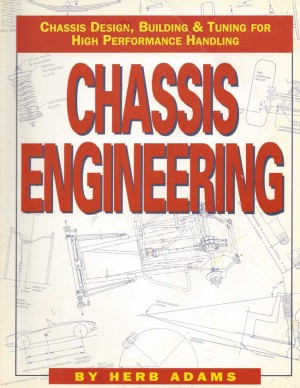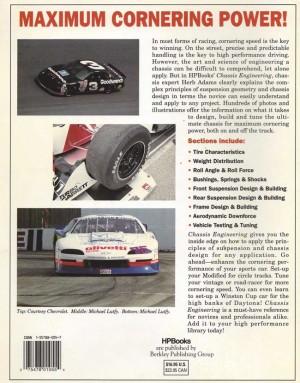Chassis Engineering: Chassis Design, Building & Tuning for High Performance Handling
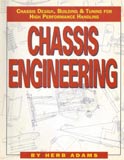
- All
Overview
Chassis Engineering is a great introduction to race car design. In a practical and down-to-earth way, it covers the fundamentals of how race cars handle and the requirements for designing and constructing a car. The book includes chapters on chassis design, suspension design, frame construction, aerodynamics and tuning. Overall it provides the reader with the foundation of how the key components of a race car work and interact together.
Review
By Matt Gartner
Herb Adam's "Chassis Engineering" is a holistic "Big Picture" guide to race car handling and design. It is one of the first books I ever read on race car engineering and I'm glad I did. In race car design, you can rarely make a single decision without knowing the impact that decision is going to have on the rest of the car—it's handling, durability, etc. This is where the "Big picture" provided by Chassis Engineering comes in.
While not as detailed as some of the design books I have seen, Chassis Engineering excels because of the methodical explanations and progression through the key elements that affect handling—weight distribution, suspension, chassis and aerodynamics. It provides formulas, diagrams and photos to help the reader understand each concept it discusses.
I found that when I had finished reading it, I could conceptualize a race car design beyond my earlier fanciful drawings. I could see the "big picture" of vehicle dynamics--weight, its transfer, grip, suspension geometry and components. I could understand the interaction between chassis, aerodynamics, and suspension.
 |
If the car oversteers coming out of a turn, the driver won’t be able to get on the throttle as quickly, which is especially important when coming onto a straightaway. To reduce corner exit oversteer, start by using a less effective rear stabilizer bar, and/or use higher front or lower rear spring rates. More anti-squat is a good solution to this problem. Photo by Michael Lutfy. |
116
Chassis Engineering was also a jumping off point, a foundation for further study. I delved deeper into the topics covered in "Chassis Engineering" by purchasing specialty books, but whenever I needed a reminder of how a car behaves, I would open my trusty copy of this book.
The book is laid out in a format that is easy to follow. The essentials of vehicle handling are discussed first, which gives the reader a clear understanding of how weight distribution and transfer affects handling. Successive chapters introduce the actual components of the suspension and suspension design as well as frame design and construction.
The author doesn't go into every possible suspension type or frame design, but covers the most popular types used in race cars today. Perhaps this is another reason this book excels—it deals with the common race car design features which are shared by most cars and in doing so doesn't overwhelm the reader with more information than needed to understand the fundamental functions and behaviors.
One of the most novel parts of this book is the demonstration of using balsa wood to make frame designs and then testing them for torsional rigidity. I have personally spent many hours cutting, gluing and testing! The great part about this method is that at the correct scale, it actually correlates to steel tubing and can form the basis of your own model.
For a first time reader or as a reference in a race car designer's library, this book offers a compact, instructive guide to the fundamentals of engineering a race car chassis and suspension.
Book Sections
Tire Characteristics
The book begins with a discussion about tires, their performance characteristics and skipad testing.
Weight Distribution & Dynamics
This section looks in detail at vehicle weight transfer, understeer and oversteer, roll forces and the use of weight transfer mechanisms like stabilizer bars.
Bushings
The bushings section looks at the various types of bushings (steel, nylon, urethane, spherical bearing) used in suspensions and their pros and cons. It also looks at the effects of deflection steer and camber loss caused by different types of bushings.
Springs/Shocks
This section looks at the role of springs and shocks in vehicle suspensions. Topics including spring rates, wheel rates, spring selection, mounting locations, and ride height adjustment are discussed. Shock absorber dampening attributes and mounting are also discussed.
The book does step into a bit of fabrication at this point too, with a how-to on coil spring cutting and lengths.
Front Suspension Design
After laying down the essential foundations of handling, the author moves on to front suspension design. The author discusses the geometry of an unequal length wishbone suspension, and uses this type as the basis for demonstrating aspects such as swing arm length, camber gain, roll center movement and bump steer. Even though it is not a detailed design of a suspension, the principles are well explained and that is what I found most valuable.
For actually playing with suspension designs, the author points to computer software, which makes a lot of sense. If you understand the principles, the computer software does the intense calculations.
 Figure 6-6. Double A-arms are preferred, because they mount the wheel and hub on rigid arms, which do not deflect during hard cornering. The problem of equal length arms is that they do not provide any camber gain. | |
for high performance use is to find a way to get the system to provide camber gain as the suspension was compressed. This problem was solved by changing the length of the A-arms. UNEQUAL LENGTH DOUBLE A-ARMThe use of a longer, lower A-arm and a shorter, upper A-arm provide a suspension geometry that causes the tires and wheels to gain negative camber as flie suspension comptesses (Figure 6-7). The reason this happens is because the shorter upper arm will cause the top of the knuckle to pull inboard faster than the longer lower arm moves the bottom of the knuckle inboard. The advantage of this gain in negative camber is that the camber angle between the outside tire and the ground will not change too much in relation to the ground during body roll. If the outside tire is kept perpendicular to the ground, it will develop its maximum cornering power, and the car will go around turns faster. Since there is little weight on the inside tire, the angle between it and the road is of little concern. With unequal length control arms mounted at various angles to the ground, it is possible to design for just about any roll center height and swing-arm length. This flexibility in the design process gives a chassis engineer many options on how to lay out a | suspension. Computer programs are available for quickly analyzing the variations, so in recent years there has been more refinement in the application of double A-arm suspensions. How long each A-arm should be, and what angle the A-arms should be to the chassis for optimum geometry, has been studied for over 50 years. Not everyone agrees on what the optimum values are, but Chapter 7 explains some of the considerations involved. There is no right or wrong answer. The bottom line is “whatever makes a car go around corners fastest.” Under some conditions, one arrangement might be better than another, and so each situation needs to be evaluated on its own merits. Figure 6-7. Unequal length control arms mounted at various angles can provide a variety of roll center heights and swing-arm lengths. The amount of camber gain is determined by the length of the swing arm and the height of the instant center. |
42 | |
Building a Front Suspension
This brief chapter (5 pages) provides some good advice on each component found in an independent front suspension, including tire, wheel, knuckle/upright, control arms, springs/shocks, stabilizer bar and linkages. Like the suspension design before, the book does not go into details, except some for some design/selection guidelines on things like the stabilizer bar.
Live Axle Rear Suspension Design
In this section, the author moves to the rear of the car, where live axle rear suspension design is discussed. He describes design requirements such as lateral control, roll center height, bump steer, and anti-squat for the various types of live axle suspension.
There are some good diagrams in this section which help to differentiate between the different linkage types, and which demonstrate the geometry.
Independent Rear Suspension (IRS)
Like the live axle section, this one looks at the characteristics of the suspension and talks about the design requirements for such suspensions. Various types including corvette, formula and Jaguar IRS are covered.
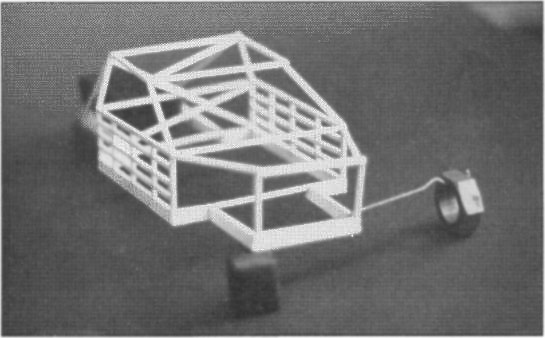
Diagram MOD1. Balsa model of a spaceframe shown in Herb Adam's book "Chassis Engineering"
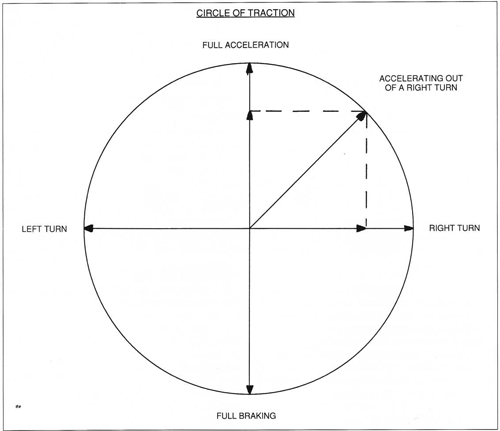
Diagram COT1. From "Chassis Engineering" by Herb Adams, showing how the circle of traction works to divide traction between different accelerations.
Building Rear Suspensions
This chapter provides brief but useful advice on various aspects of constructing the rear suspension. Both live axle and IRS are discussed. Topics such as live axle lateral location, links, camber and IRS rear suspension components are covered.
Frame Design
One of my favourite chapters in this book, Frame Design covers the basics of structural design using balsa wood stick (representing tubes) and balsa sheet (representing sheer panels) models. The examples beg to be tried on your own and give an excellent opportunity to model your chassis and car in small scale.
The author also discusses different types of frames (Ladder, backbone, and their features) as well as frame layout.
Building the Frame
This section looks very briefly at the construction of a tube frame for a short track oval race car. There is some practical advice, but it very minimal and it is not a guide to fabrication. It might be better called "Frame building and testing tips"
Aerodynamic Downforce
This section provides some very basic aero theory for the reader and then proceeds into several practical examples of using the aerodynamics of the car in various types of racing. There are some good illustrations and photos to help the reader understand the use of air flows, aero devices, downforce generation and the use of air flow for cooling. In all, it provides a good practical overview of aerodynamics that adds to the learnings from the previous chapters.
Rotating Inertia
The rotating masses of the driveline and running gear are discussed in this section. The author discusses the goal of reducing these masses to improve acceleration and ultimately top speed in a race car.
Tuning Techniques
Tuning the final product is given a fair bit of treatment in this book. The section begins with instructions on aligning the front and rear wheels to obtain good results from tuning. Then it moves on to the process of testing using a G-Force logger and test procedures. The book discusses the results and recommends adjustments to the car depending on the logger outputs. It is a useful concept especially for validating a new car's handling.
Helpfulness to amateur race car designers
This book is a broad introduction to race car design and an ongoing reference for the designer. It methodically builds the key knowledge a person needs about race car design. From handling, to design and construction, to testing, it gives the reader an overall perspective of how race cars are put together and how each component affects the others.
73

 (
(


